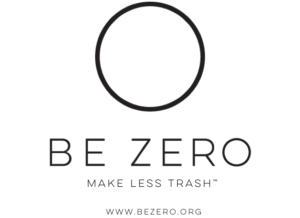Ecocity 30 Day Zero Waste Challenge
This is your opportunity to become more conscious of your consumption patterns and transform your everyday choices to deeper shades of green. Document your journey on Instagram and follow along with ecocitizens around the world to share/compare what ecocitizenship looks like in different cities and cultures. The 30 challenges on this page will equip you with actionable items. As you tackle one challenge each day (or however many you have time for), document it with a photo (or video!) and tag #EcocityGoingZero #ZeroWaste (and others you see fit).
How it works
- Step 1: Sign up here.
- Step 2: Familiarize yourself with the challenges by clicking on the challenge tiles below.
- Step 3: Share your day by day journey on Instagram #EcocityGoingZero.
The 30 Challenges


DAY 1
Say no to plastic straws
CHALLENGE
Refuse or bring your own. Make a personal commitment to say "no" to plastic straws. Anytime you order a drink, ask for “no straw” or don’t take one.
Why?
Plastic straws are "single-use disposable" waste items. A single-use disposable is anything you use once and toss (think plastic water bottles, to-go containers, plastic utensils, and plastic-lined disposable coffee cups). These single-use plastics are a problem because they take up landfill space, pollute our waterways, kill wildlife, and they are made from a material that isn't digested by the planet.
Alternatives
If you prefer to use a straw, there are plastic-free reusable alternatives (stainless steel, bamboo, and glass) that you can carry when you go out.
Resources:
Life Without Plastic
Glass Dharma Straws
The Last Plastic Straw
Surfrider Foundation
Plastic Pollution Coalition
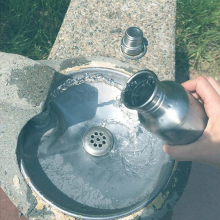

DAY 2
Use a reusable water bottle
CHALLENGE
Stay hydrated all day long by using just one bottle or container to drink from. Use tap or filtered water to refill your bottle, if available.
Why?
60 million water bottles are landfilled a day. A DAY. That's a lot of plastic bottles. And, plastic can't really be recycled. It's downcycled, and with oil prices so low it's more expensive to use recycled plastic. A lot of our plastic is landfilled at the recycling plant. There's no incentive to recycle it at all right now.
Alternatives:
There are stainless steel, glass, and plastic varieties of reusable bottles you can choose from, but you can also reuse a juice bottle or a glass mason jar. Be resourceful!
Resources:
How to choose and maintain a water bottle

DAY 3
Bring your own cup

CHALLENGE
Bring your own reusable cup for getting coffee, tea, or cold drinks to go. Many establishments will give you a small discount for bringing your own cup. Or, if you’re staying and the establishment has them, ask for your drink in a real mug or cup.
Why?
One million disposable cups end up in the landfill every minute. Many of these cups appear to be made of paper, but actually they are commonly lined with polyethylene and attached with polystyrene lids. Because of this very thin lining of plastic inside the cup, they can't be recycled.
Alternatives:
There are ceramic, glass, stainless steel, insulated, and plastic varieties of reusable mugs or cups you can choose from. Choose what suits your lifestyle and needs.
Resources:
How To Successfully Implement a Bring Your Own Mug (BYOM) Habit

DAY 4
Use your own food container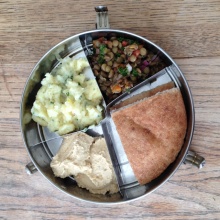

CHALLENGE
Refuse disposable to-go containers and utensils whenever possible! Avoid single-use containers for transporting food. When dining out, bring along a container to take the leftovers to go. If you’re getting a take-out, bring your own container to the eatery. Carry your work/school lunch in a reusable container.
Why?
Takeout usually means lots of waste afterward. Restaurant leftovers often includes lots of plastic, polystyrene boxes and plastic bags in addition to plastic wrapped utensils, napkins, plastic sauce cups, drinking cups and any number of other unneeded single use items that commonly get thrown in with your food.
Alternatives:
From mason jars to stainless steel containers and bento boxes and actual dishes and reusable bags and beeswax wraps, there are plenty of options for bringing food to work or school or even taking food home from a restaurant. Make sure you also have reusable utensils with you.
Resources:
Reusable food storage ideas
DIY reusable sandwich or snack bags
Life Without Plastic


DAY 5
Get outside
CHALLENGE
Explore the world around you — get outside.
Why?
Part of a zero waste mindset is to put value back into our natural world as well as our urban environments. It means that we see our natural and human ecosystems as unique and vital parts of our collective survival. It means we consider how and where we are all connected. Life can be greatly enriched by experiences that happen in real time, outside and away from distracting devices.
Alternatives:
Go for a walk. Take a hike. Pack a (zero waste!) picnic. Sit on the stoop and watch the world go by. Visit a local park, wildlife refuge or sanctuary. Most of these are free! There are a million ways to be engaged with the physical and cultural world around us. Share what floats your boat!
Resources:
Open your front door.
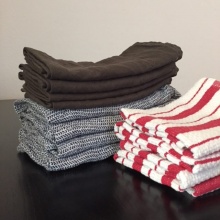

DAY 6
Reduce single-use household paper products
CHALLENGE
Replace paper towels, napkins, and tissues with reusable cloth alternatives. Use cloth towels when drying your hands in the kitchen or bathroom. Substitute cloth handkerchiefs for blowing your nose. Pack a cloth napkin with your lunch or when getting food to go (in your reusable container). You might be wondering about toilet paper? Look for 100% recycled post-consumer waste or tree-free products.
Why?
Paper napkins are a huge source of waste, and most people grab a lot more than they actually use. Cloth is easy to wash, and can also be made out of old clothes. Beyond just the throw-away culture, commercial paper products (like tissues and paper towels) can often come from virgin forests and also contain a host of chemicals for whitening and processing. Many commercial brand tissues are bleached with the most common offender, chlorine. Chlorine is in many paper-based products; such as paper towels, toilet paper, tissues, coffee filters, and milk cartons. These toxic substances pollute our waterways and even enter our bodies through our skin and get into our bloodstream. Why spend the time and energy to go to a store, spend good money on something, just to toss it after one use? Save money, save time, use less storage space.
Alternatives:
Use a bandana, an old t-shirt, cut up bed sheets you no longer use, etc.
Resources:
An Un-fussy Cloth Napkin How-to
Who Gives a Crap (paper-free products!)
The Hanky Book

DAY 7
Eliminate single-use plastic bags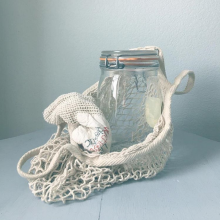

CHALLENGE
Say no to plastic grocery and shopping bags. Refuse complimentary plastic bags when you don't need a bag at all and bring your own bag when you do.
Why?
5 trillion plastic bags worldwide are produced yearly, and only 1 to 3% of them are recycled. Plastic will only start degrading after 700 years and will only fully degrade in 1000 years. This means that all the plastic that has ever been produced has not degraded yet. Even after it degrades, it breaks down into smaller and smaller toxic bits of itself. Not something you necessarily want around your food or drink or in the environment. Plastic isn't digested by the planet, so avoid it in single-use applications as much as you can. Plastics are not evil, we just greatly misuse the material.
Alternatives:
Use cloth or other reusable bags to carry your groceries. You can use mason jars, tupperware, metal boxes (if you'd like to invest, check Life Without Plastic) and other storage for bulk items (nuts, fruits, cereal, etc) and mesh bags for loose vegetables. Use wax paper bags or wraps for sandwiches and snacks (or see options in "Enjoy Waste Free Snacks" challenge).
Resources:
Ecology Center’s guide for storing produce sans plastic
How to make your own
Plastic Bag, a short film by Ramin Bahrani
Bag Monster
Life Without Plastic

DAY 8
Enjoy waste-free snacks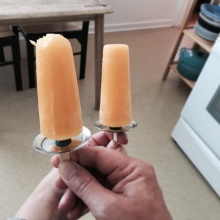

CHALLENGE
Swap out a packaged snack for a zero-waste snack.
Why?
Eliminate waste from excessive packaging. Added bonus: Unpackaged snacks are usually healthier than their packaged counterparts.
Alternatives:
Fresh seasonal fruit, crunchy veggies (i.e. carrots, jicama sticks, celery, snap peas). Make your own trail mix with an assortment of seeds, nuts, and dried fruit. Bake cookies or snack bars.
Resources:
Going Zero Waste Snack Challenge
A list of easy, healthy, unpackaged snacks
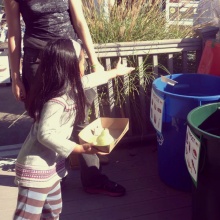

DAY 9
Become a better recycler
CHALLENGE
Reduce the amount of recyclables in your life. Educate yourself about what can be recycled in your local municipality.
Why?
The items you place in the recycling bin each week are not guaranteed to be magically turned into another usable item. Recycling is a business. Which means if there is no one to buy the materials we offer up to our recycling bins each week, then those items head (most likely) to a landfill or incinerator instead of renewing themselves into a product. Materials must have value to be used for another application. And if it doesn't have value, then there is no need in buying that material. So if we as consumers are not buying materials made from recycled products, then there is no reason for the manufacturers to buy recycled content from recyclers. Recycling is not the same everywhere. Just because a product has the chasing arrows recycling symbol on it, it does not mean it can be recycled where you live.
Alternatives:
By refusing, reducing, and reusing items that you purchase and bring into your home, you can concentrate on making less waste in the first place instead of only recycling more waste. Inspect items before you buy them — the more different materials they’re comprised of, the less likely it is that they’re recyclable or will be recycled. Avoid things that come in excessive packaging, especially plastic wrappers. Research your municipality’s recycling program to make sure you know which materials will actually be recycled. Minimize or eliminate online shopping to reduce packaging.
Resources:
How to Recycle
Plastics Pile Up as China Refuses to Take the West’s Recycling
The only way to solve the recycling crisis is to stop making so much trash


DAY 10
Have a money-free day
CHALLENGE
Seriously. Have an experience. Turn off the television and social media for a day. Leave the cash, credit cards, and temptations far away from you. Create time!
Why?
Time is a precious commodity that too many people don’t think they have enough of. And yet, we “waste” a lot of it by looking at screens and chasing after products and prepackaged experiences. Plus, with marketers vying for every free minute of our attention in our physical as well as online environments, they’ve successfully made us accustomed to thinking that there’s a price tag on our most valued experiences. Whether it’s music, arts, sports, or any number of activities, we’ve been conditioned to think that entertainment is intrinsically linked to consumption and must be purchased. We’ve even created “amusement parks” specifically designed for us to pay and consume to be amused. And yet, there are a million ways to be “a muse” without buying a single thing. Using what we already have, including our imagination, not only reduces our footprint and breaks the consumption cycle but teaches resilience and how much effort it takes to not spend any money when the norm is currently the other way around.
Alternatives:
Bring friends or family together for food, conversation, or card/board games. Dust off that old guitar or percussive instruments and jam on the front porch. Read a book. Walk around the neighborhood or be a tourist in your own city. Visit your local library. Connect with your local “Buy Nothing” group to stay updated.
Resources:
Buy Nothing Project
Things to do on Black Friday

DAY 11
Unpackage your soap

CHALLENGE
Skip the liquid hand soaps and body washes that come in plastic bottles and switch to the simplicity of a bar of soap.
Why?
According to researchers at the Swiss Federal Institute of Technology in Zurich, bar soap requires one-fifth of the energy to produce compared to liquid soap. Liquid soap is typically produced using a variety of different chemicals, technically making it more of a detergent than soap. Furthermore, this liquid can use up to 20 times more packaging than bar soap and contains significantly more water, making it heavier and less efficient to transport from where it’s produced to where it’s used.
Alternatives:
Choose bars of soap without packaging, or if that’s not available, wrapped in paper. Paper can be put in compost. Choose soap based on ingredients. For liquid dish soaps, choose castile soap if available, a variety of mild soap made from olive oil and sodium hydroxide. Look for alternatives for shampoos and deodorants, like baking soda, apple cider vinegar, or lemon juice. For laundry detergent, try soap nuts.
Resources:
How Do Detergents and Soaps Work?
The Benefits of a Bar of Soap
10-Minute DIY Milk & Honey Soap
7 Hacks For Washing Your Hair Without Shampoo
5 Reasons You Should Start Using Soap Nuts
Solid Plastic-Free Shower Gel and Body Wash
Lush Shampoo Bars

DAY 12
Clean up your cleaning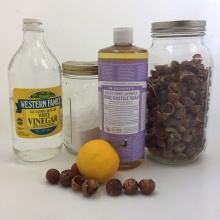

CHALLENGE
Replace chemical cleaners with homemade natural ones!
Why?
Marketers want to make you believe that you need a “special” cleaning product for every appliance, surface, and corner in your kitchen. Not true. Commercial cleaners often contain irritants and chemicals that aren’t friendly to those with allergies and sensitivities. They are more expensive (you’re paying for the branding) and come in wasteful plastic containers. Water comes from the tap, baking soda comes in cardboard (or buy it in bulk), lemon juice comes from...lemons. Natural ingredients are healthier for all members of the household and for the environment.
Alternatives:
You would be amazed at the cleaning power of plain old white vinegar and water - it worked just fine for our grandparents’ generation. Try using an all-purpose cleaner of 1 part vinegar to 4 parts water in a glass spray bottle. This solution can be used on counters, the stove, windows, cabinets, and even the floor. Baking soda & lemon juice are also potent cleansers.
Resources:
Dish Soap
DIY cleaners
SF Environment’s Green cleaning guide
Make your own cleaning products
Going Green with a Bronner Mom


DAY 13
Declutter
CHALLENGE
Pick one pile, shelf, or drawer to sort through. Put away what you wish to keep and recycle or collect in a “donate” or “giveaway” bag what you no longer need.
Why?
Because you can find what you’re looking for when you need it, in the long run, decluttering and getting more organized saves you time and money while increasing your peace of mind and productivity. When there is too much clutter in our lives, it’s easy to misplace or lose things, resulting in the need to purchase duplicates, triplicates, or quadruplicates of things you already own, many of which will ultimately end up in a landfill. Put respect and value in your belongings and they will be ready to serve and inspire you when you need them most.
Alternatives:
Evaluate your wants and needs: Putting value back into our belongings is a huge step to keep clutter away. If we love and value something we keep a good eye on it, we take care of it, repair it, use it well, and it's something we want to even pass down to our future family.
Rethink future purchases: Make purchases based on functionality, repairability, and durability. Less, but better.
Life editing: remove what no longer serves you, inspires you, or is useful!
Resources:
Decluttering Guide
5 Tips for Downsizing and Decluttering
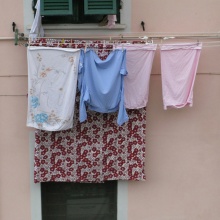

DAY 14
Air dry laundry
CHALLENGE
Dry your laundry naturally.
Why?
It's no secret that over washing and over drying shortens the lifespan of your clothes — especially your delicates, which you should always hand wash (or at least wash on cold) and line dry. Dryers also typically use up more electricity than any other household appliance — when you line-dry, your monthly electric bill will be considerably lower. You will go through less laundry because you’ll be more aware of whether your clothes actually need to be washed or if they can be worn another time. You will eliminate the need for dryer sheets which are full of toxic chemicals.
Alternatives:
Wet clothing can be hung on regular hangers and hung on the shower bar, doorknobs, balconies, or anywhere inside or outside your home. Foldable drying racks are great to use indoor or out and they take up little space in a closet or beneath a bed when not in use. If you have access to a post or tree, put up a laundry line. See how creative you can be!
Resources:
Air Drying Clothes Without A Clothesline
5 Effective Tips for Hanging Clothes to Dry Inside
How to Line-Dry Laundry

DAY 15
Walk, bike, or take public transit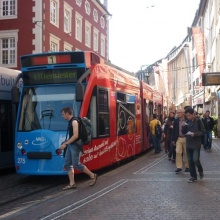

CHALLENGE
Keep your mobility footprint small. Walk, bike, take public transit.
Why?
The current 1.2 billion fleet of automobiles worldwide that is projected to grow to 2 billion by 2035 and double to 2.5 billion in 2050 is not only the largest net contributor to climate change pollution, but their production, distribution, infrastructure needs, and disposal is one of the biggest waste problems on the planet. Getting out of our private automobiles and developing alternative transportation for communities offers up advantages like safer streets and more access to local shops and establishments. These help create closer knit communities, reduce traffic, pollution, and slowly re-develop urban planning to include alternative transportation. It's also way cheaper than owning and maintaining a vehicle.
Alternatives:
When it comes to alternative forms of transportation, it can be especially hard when our towns and cities are not set up for biking, walking, or public transit. If that is the case, start with ride shares. Plan your trips to combine errands. Bike on a safe street and ask some friends to join you for a critical mass. Gather your community and advocate for walkable and bikeable infrastructure with your local government. Make some waves. One person can make difference.
Resources:
Car is Over (if you want it)
People for Bikes
WalkScore

DAY 16
Save water

CHALLENGE
Reduce your daily water usage. Take shorter showers. Turn off the water when you’re brushing your teeth or shaving. Either turn off the water while you soap your dirty dishes, or fill a bucket (or the sink) with soapy water for washing dishes. If you have a dishwasher, only run it when full. If you must run water to heat the shower water, use a bucket to catch the cold water. Use the captured water for watering plants or flushing the toilet.
Why?
Water is life, and we cannot survive without water. At the same time, only 1% of all the earths water is actually drinkable. According to the UN, water is at the core of sustainable development and is critical for socio-economic development, energy and food production, healthy ecosystems and for human survival itself. Water is also at the heart of adaptation to climate change, serving as the crucial link between the society and the environment.
Alternatives:
Some municipalities offer free low flow fixtures. If your city doesn’t, check with your local hardware store. Low flow toilets, shower heads, faucets. (The latter two are easy and inexpensive to change). Find and fix leaks. Rainwater harvesting. If you have a yard, plant drought-resistant plants and go lawn-free!
Resources:
Ways to save water at home and in your yard
National Geographic Water Conservation Tips
World Water Day
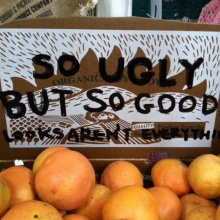

DAY 17
Reduce food waste
CHALLENGE
Eat the food you buy, buy only what you need, pre-plan meals, store food properly, and be more resourceful with your meal and leftover planning.
Why?
According to the UN Food and Agriculture Organisation, roughly one-third of the edible parts of food produced for human consumption — about 1.3 billion tons per year — gets lost or wasted globally. In the United States alone, about 63 million tons of food go to waste every year, accounting for almost 21% of all freshwater used going towards agriculture to grow food that isn’t even eaten. In addition, only 5% of the food that is thrown away is getting composted, making food the largest category of waste making its way to landfill.
Alternatives:
Plan meals and shop with a grocery list to avoid over buying and to avoid excessive leftovers. Shop more frequently by buying only what is needed to avoid over-buying. Buy directly from farmers and growers, including fruits and veggies with imperfections. Store fruit and veggies appropriately to prolong shelf-life. Use the right amount of water for cooking pasta or veggies. Use leftovers to create new and interesting meals. Learn how/if you can use parts of vegetables you usually discard or ignore. Invest in basic measuring cups, and make a habit out of measuring the amount of food and water you use.
Resources:
Stop Food Waste
27 Solutions to food Waste
Zero Waste Chef
Farmers’ Market Tips on Storing Fruits and Vegetable
Feedback Global
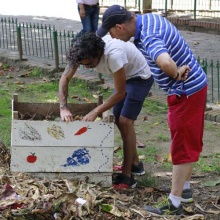

DAY 18
Compost
CHALLENGE
Explore ways to compost leftover food scraps and other organic waste.
Why?
The food scraps (and often entire meals — remember from the previous challenge that 63 million tons of food in the US and 1.3 billion tons worldwide gets thrown away every year!) we toss in our trash cans go straight to landfill (or incinerators in some parts of the world) where they take up space, lose their inherent nutrient value, and produce methane, a potent greenhouse gas. By composting we not only keep organic waste out of the landfill but return valuable fertilizer to the earth.
Alternatives:
If your municipality has a composting program, be sure to educate yourself about which items are accepted. Compostable items could include veggie and fruit scraps, egg shells, meat and bones, plant material (ask your local facilities about yard waste!), paper, cotton balls and swabs (with paper rods). If your city doesn’t have a composting program, check with your local farmers’ market, natural market, neighbor, or even a community garden if they have a compost you can contribute to (you can store compostables in the freezer or use a bucket with lid until drop-off or pick-up). If you have a backyard, consider setting up your own composting system. Don't put commercial compostable items (straws, utensils, cups, containers) in your home compost. They are not designed to break down in your home unit.
Resources:
The Benefits of Composting & Compost Use
Backyard Composting
The Real Dirt on Urban Compost

DAY 19
Clean your neighborhood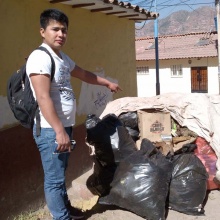

CHALLENGE
Safely pick up five pieces of trash (i.e. cigarette butts, bottles, straws) from the sidewalk, beach, or local park and dispose of them properly.
Why?
Picking things up that have been carelessly dropped, left behind, or fallen down gives you a stake in keeping the neighborhood clean for yourself and others. When you start doing it, others will see you and may be inspired to do the same. By collecting trash on the sidewalk, in the gutter, or on the beach we bring not only cleaner streets but awareness and civic pride to our community.
Alternatives:
Invite your neighbors to join you. Post a sign announcing a clean up day. Find a community beach, park, or sidewalk clean-up near you. Adopt a storm drain to keep the street clear during upcoming rains.
Resources:
How to Pick Up Trash in Front of Your Home
International Coastal Cleanup
Cleaning Up Your Neighborhood Park

DAY 20
Each one teach one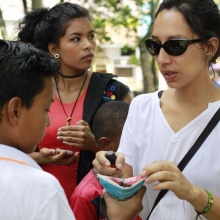

CHALLENGE
Tell someone else about your zero waste challenge experience.
Why?
Your voice counts! Talk to a friend or a coworker about any of these practices, and encourage them to take on the challenge as well! The more people are involved, the less we waste! Children are also always eager to learn, and starting off the new generation with clean, wasteless, practices is fundamental. Most zero waste practices are very simple and easy to take on, so create a challenge with your best friends, your office, or gym buddies, and show them how easy it can be to waste less.
Alternatives:
Share your experience with friends and family near and far on social media.
Resources:
The other 29 challenges.
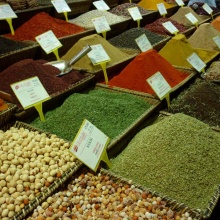

DAY 21
Reduce waste from grocery shopping
CHALLENGE
Reduce waste while shopping for groceries by changing your choices and habits. When you can, buy food in bulk or unpackaged (grains, dried beans, fruit, vegetables, sweets, etc). Whenever non-plastic packaging is an option, pick the products that still come in paper or compostable sacks (sugar, flour, bread). Choose beverages and condiments that can be bought in glass bottles.
Why?
Grocery stores are filled with single use plastics and unnecessary packaging. By choosing and requesting bulk and uncontained products, we not only help save resources, minimize garbage, and bring home less packaging to store and dispose of, but we create a demand for stores to offer new or expanded bulk sections and products that come with less packaging than what we’ve become accustomed to in the linear economy.
Alternatives:
Next time you buy bread from a bakery, bring a basket and cloth to wrap it in — not only will you bring home zero waste and a delicious loaf, but a hearty approval from your baker. Bulk food tips: In order not to pay for the weight of your own bag or jar when you check out, you'll need to have the weight (the tare) written or committed to memory. If your bag doesn't have a tare weight on it, bring the empty bag to the service desk of any grocery store and have them weigh out the bag. Once you know the weight of the bag you can now tell the cashier so she can subtract that amount from the bulk goods inside. This also avoids paying an extra fee for bags at stores.
Resources:
Ultimate Guide to Zero Waste Grocery Shopping
How To Throw A Zero Waste BBQ
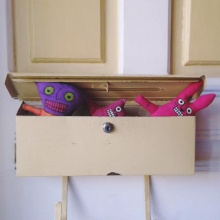

DAY 22
Put your mailbox on a diet
CHALLENGE
Reduce unneeded and unsolicited paper delivered through your mailbox. Unsubscribe from junk mail and catalogs you no longer wish to receive. Switch to paperless billing, statements and publications whenever possible.
Why?
The average American home receives about 850 pieces (appr. 41 pounds) of unsolicited mail every year, for a total of over 100 billion pieces nationwide! (In the UK, it’s over 17.5 billion, in Australia 8.2 billion). Almost half of all junk mail (about 5.6 million tons) ends up in landfills without even being opened. That’s in addition to billions of tons of paper from unread newspapers, magazines or financial statements. Aside from the environmental effects of the destruction of over 100 million trees and the production of more than 51 million metric tons of greenhouse gases every year for the production of junk mail alone (equal to that of seven U.S. states combined!), this heavy paper weight takes a toll on our personal lives. According to Ecocycle, Americans may spend as much as eight months of their life sorting junk mail, overwhelming us with unwanted paper clutter and wasting our precious time. In short, junk mail and other unneeded paper deliveries can be a real pain, but the good news is that canceling it can be much easier than you think.
Alternatives:
Write “Do not sell, rent, or trade my name” any time you sign up or order any new product or service to stop the junk mail cycle before it begins. Avoid filling out warranty cards. Return unopened junk mail with first class postage with the message “Refused: Return To Sender” to remove yourself from their list. Use free opt-out services (see Resource section). If you’re in Europe or Australia, placing a “STOP unsolicited mail” sticker on your mailbox can save dozens of kilograms of paper.
Resources:
Junk Mail Box: Stopping Paper Waste
Stop Waste: Stop Junk Mail
Junk Mail Facts
Junk Mail FAQ
Zero Junk Mail in Europe
Stop Junk Mail: 7 Ways to Reduce It and Opt Out for Good
How to Stop Junk Mail
Opt-Out Prescreen
ValPak Mailing List Removal Form

DAY 23
Refuse freebies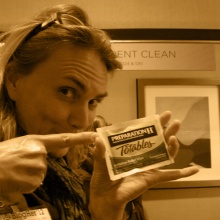

CHALLENGE
Just say no to stuff you don’t need!
Why?
Free samples might look like a big catch, but how often do we really use them? Ask yourself these questions when presented with a freebie:
• Is it useful? And will I actually use it?
• Will I still want this in a month or two? Will it last that long?
• Will I regret it later if I don’t take this?
If the answer is no to any of these questions, respond with a “no thank you!” and keep on moving. You won’t hurt anyone’s feelings. Refusing a free sample can be just as easy and polite as taking it in. If you are positive that you will not use that plastic-packaged tiny free sample, politely refuse it, and just like that you become less wasteful.
Alternatives:
If the swag is prepared for you in advance, like a race bag, consider emailing the event organizers to let them know you’d like an option next time. Refuse promotional flyers, cards and samples given out in stores or on the street. Say no to the extra paper napkins given to you at the coffee shop. Take note of things that magically found their way into your pocket that you didn’t intend to acquire.
Resources:
Just say no! Refusing freebies

DAY 24
Dress sustainably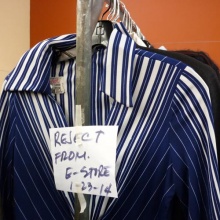

CHALLENGE
Reduce the amount of clothing you buy new.
Why?
Each garment you buy new used a lot of resources to make. Additionally, there is a surplus of clothing that people don’t want anymore and will end up in a landfill.
Have you ever thought about where your clothes were made? Or what they are made of? Believe it or not, much of our clothing (fleece, nylon) is made from synthetic materials, aka plastics, and sewn thousands of miles away. Making the plastics that then become our clothing requires burning fossil fuels and usually correlates with poor quality garments that you will have to toss within a year, ending up in landfills. Before synthetics, all our clothing was made of natural fibers (cotton, wool, silk, hemp) that were built to last and were completely biodegradable.
Alternatives:
Reduce the amount of clothing you buy new. Host a clothing swap with friends, buy from a secondhand or vintage shop, repair what needs fixing. If you need to buy something new, try to find something made locally and made with natural fibers. Make sure any new garment you buy is high quality and will last you for many years. Recycle usable clothing by donating to charities that give clothes away to those in need, recycling textiles through ICO
Resources:
These African Countries Don’t Want Your Used Clothing Anymore
The Environmental Cost of Fast Fashion
Fibershed
The SWAP Team
Billions of Plastic Hangers go into Landfills Every Year
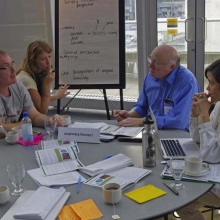

DAY 25
Create workplace/school sustainability
CHALLENGE
Take the initiative to propose changes in your office or school to be more sustainable.
Why?
The average office or school generates a substantial amount of waste. Much of the total waste is made up of paper such as office paper or disposable cups, with the balance consisting of food waste. Considering the majority of our days are spent in the office or in school, it’s just as important to focus on reducing, recycling and composting there as it is anywhere else.
Alternatives:
Double-sided printing, change to printer paper with high post-consumer content, replace disposables with reusable dishes and cutlery, recycle food and beverage containers, change to nontoxic cleaners, ditch the alkaline batteries for their rechargeable replacements. Inquire about any existing recycling or composting pick-ups in your building, and if non-existent, talk to the building manager about how to arrange for one.
Resources:
Sustainability at Work - City of Portland
How to Start a Reusable Takeout Container Program at Your College
School Compost Programs: Pathways to Success
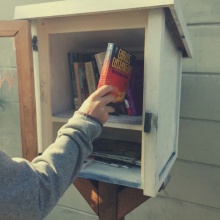

DAY 26
Share (or borrow) something
CHALLENGE
Share with or borrow something from a friend or neighbor.
Why?
Industrial age beliefs about how the world works — that ordinary people can’t govern themselves directly; that nonstop economic growth leads to widespread prosperity; and that more stuff leads to more happiness — no longer serve our modern times, both physically and spiritually. When individuals embrace sharing as a worldview and practice, they not only reduce their physical footprint but experience a new, enlivening way to be in the world. Sharing is fun, practical, and perhaps most of all, it’s empowering. It enables us to reconnect with each other and do things we never thought possible.
Alternatives:
Give away item/s you no longer want through neighborhood groups. Donate to a local thrift shop or creative reuse center. Host a potluck or a clothes swap. Find online places like craigslist, nextdoor, or freecycle to donate or trade.
Resources:
Shareable Community
Buy Nothing Project
Little Free Library World Map

DAY 27
Repair something

CHALLENGE
Fix something that’s broken. Sew a button, stitch a tear, patch a hole, darn a sock, glue a chip, or find someone who can.
Why?
If you've ever found yourself on the phone with a customer service representative telling you it would cost more to fix your electric tea kettle than to just buy a new one, you are well acquainted with the concept of "planned obsolescence". The good news is that people across the world are getting wise to the intentional design flaws hoisted upon us by clever manufacturers eager to sell more products, and are coming up with new and creative ways to salvage perfectly usable things. Repairing broken but fixable items extends their life cycle and keeps something useful in circulation and out of landfill.
Alternatives:
Seek out a local tailor, seamstress, cobbler, repair shop, or repair cafe. Start a repair cafe.
Resources:
Repair Cafés
How to Sew a Button
IFixIt Repair Guides
How to Start a Repair Café

DAY 28
Do It Yourself (DIY)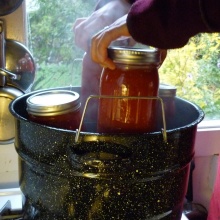

CHALLENGE
Make something that you usually buy.
Why?
Most commercial products are expensive, overpackaged, and carry a huge carbon footprint. From food to cleaners to household items, we live in a world where things that used to be easily homemade are now wrapped in plastic and shipped around the world just to fill one small need. Aside from keeping materials out of the waste stream, DiY has many other benefits, from saving cash to being creative to better appreciating the things you have and the systems that make it possible. Trying a DIY version of otherwise prepackaged items can be fun and wasteless, and if you’re going the food route, healthier!
Alternatives:
If you don’t have time to DIY, a good alternative is to buy from people who do. Frequent your local independent craftspeople or stores that sell their wares.
Resources:
Maker Faires around the World
DIY, Zero Waste, All-Natural Hygiene Product "Recipes"
Plastic-Free Laundry Ideas
Homemade Natural Makeup Recipes
Wild Fermentation Guide
DIY Network
DIY, Zero Waste Granola with Dried Blueberries
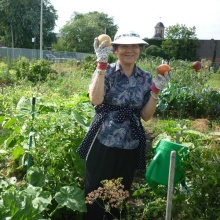

DAY 29
Live local
CHALLENGE
Support local independent businesses, markets, and work-owned co-ops.
Why?
This is a central aspect of the zero waste mindset. Rather than distancing ourselves from the supply chain, we are putting a face, a name, and a story with what we consume. By supporting our local economy we're not only encouraging goods to be made closer to us and in our own community but reducing our own carbon footprint and that of our vendors and suppliers.
Alternatives:
Walk around your neighborhood to find your local food, makers, and resources. A few examples of places to buy things locally: Farmers Market, Book Stores, Co-ops, Locally Owned Cafes, Craftsmen, Plant Nurseries, Hardware Stores.
Resources:
10 Farmers Market Shopping Tips
Stop Waste Buy Green Guide
10 Reasons to Support Farmers Markets
62 of the World’s Best Independent Bookstores


DAY 30
Power down
CHALLENGE
Be more aware of your energy consumption. Unplug.
Why?
While most of us don’t even notice it anymore because we’ve become so used to it, almost every waking minute of our modern day existence is spent plugged in to some electronic device, using precious energy that took the earth millions of years to produce (in the case of fossil fuels) or complex infrastructure to deliver (in the case of solar, wind, or hydro power). From our morning coffee and shave to the computers at work to the television in the evening and our phones almost 24/7, even a minute without power has become almost unthinkable. Most of the devices we use are being constructed according to the planned obsolescence principle, meaning they break after just a few years of usage and repairing them is more expensive than buying a new one. And thus, in addition to the pollution and greenhouse gases created from powering our smartphones, xboxes, and bluetooths, our daily habits are producing an ever-growing mountain of electronic waste.
Alternatives:
Turn off your devices when done using them. Leave the house without your phone. Set designated times for devices you normally use 24/7. Do an inventory of all electronic items in your home and ask yourself which ones you can’t live without. Spend more time outside.
Resources:
The Battle Against Planned Obsolescence
The 12-Step E-Tox
How to avoid using electronic devices
There isn't a way to actually make zero trash right now, because everything we do is linked to an infrastructure that is linear. What we can do is create a mindset that helps to navigate us through our current disposable culture. A circular mindset is a way to rethink our daily consumer and lifestyle habits to help us reduce our trash and plastic footprint. It's also a mindset that encourages us to add value back into the things we use, the communities we live in, the food we eat, those who create the materials we consume and the resources used to make them.
Andrea Sanders, Be Zero
Our Partners
Helpful Tips
- Don’t let your summer travel plans get in the way. You can do a lot of challenges while visiting other places.
- If a challenge is not feasible or practical for you, share why. Learning about obstacles is just as important as celebrating achievements as we move toward living more sustainably.
- If a challenge or its benefits aren’t available to you personally, be a change agent for others. Talk to people, share your ideas/concerns, educate.
- If a challenge is not applicable to where you are, think about what might be a substitute.
- If a challenge is not applicable/doable for you on a certain day, do it on another day when it’s a more natural fit. If you can do it before the scheduled day, you can get ahead of the game!
- If a challenge feels too difficult or disruptive to your life, just do a small part of it or delve more deeply into a previous challenge.
- If a challenge is unclear or confusing, remember the 5 Rs: Refuse, Reduce, Reuse, Recycle, Rot.


